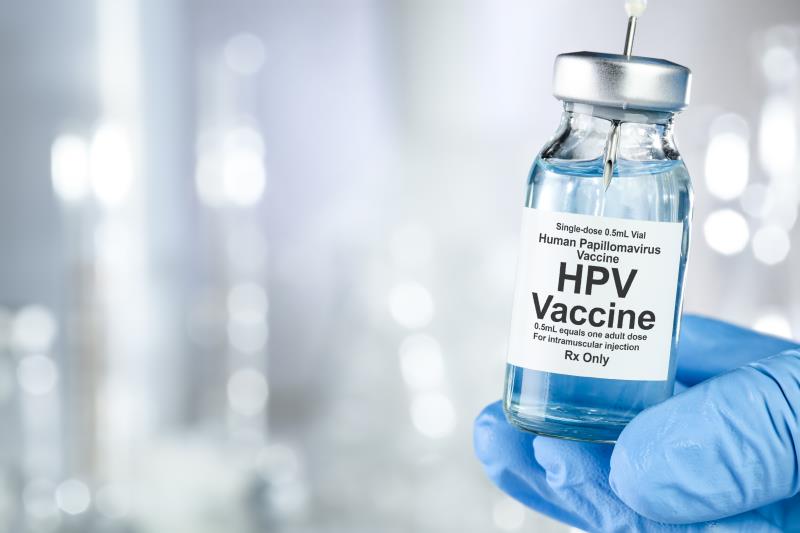The AS04-HPV-16/18 vaccine demonstrated immunologic superiority over the HPV-6/11/16/18 (4vHPV) vaccine in asymptomatic young women living with HIV (WLWH), translating into longer lasting or more robust protection against cervical cancer, a phase IV study suggests.
Compared with HIV-negative women, WLWH have higher rates of persistent HPV infection and are at greater risk of developing cervical cancer. [http://www.who.int/wer/2017/wer9219/en, accessed June 18, 2020; J Infect Dis 2004;190:37-45] As most cervical cancers are attributable to high-risk HPV types 16 and 18, [Lancet Oncol 2010;11:1048-1056] HPV vaccination appears highly beneficial in this setting, noted the researchers.
A total of 546 women (mean age 19.8 years) were randomized 1:1 to receive at least one dose of AS04-HPV-16/18 or 4vHPV 0.5 mL. Of these, 257 were WLWH (stage 1), while the rest were HIV-negative. The study duration included an active phase up to month 7 and a follow up phase until month 24. [E Clinical Medicine 2020;doi.org/10.1016/j.eclinm.2020.100353]
The primary immunogenicity endpoint was met, as reflected by the noninferiority and immunologic superiority of AS04-HPV-16/18 over 4vHPV in WLWH at month 7 – the anti-HPV-16 and HPV-18 neutralizing antibody titres were 2.74- and 7.44-fold higher with the former than the latter (p<0.0001 for both).
“[These findings show] significantly higher anti-HPV-16 and HPV-18 neutralizing antibody titres [with AS04-HPV-16/18] … The AS04 adjuvant system in AS04-HPV-16/18 is likely to play a key role in the difference of immunogenicity and efficacy profiles between the two vaccines,” said the researchers.
Interestingly, a similar response among HIV-negative women was seen, given the 3.05- and 5.38-fold higher anti-HPV-16 and HPV-18 neutralizing antibody titres (p<0.0001 for both) with AS04-HPV-16/18 vs 4vHPV. This is remarkable, given the overall lower antibody responses among WLWH vs HIV-negative individuals, noted the researchers.
By month 24, WLWH who received AS04-HPV-16/18 maintained a high seroconversion rate for HPV-16 and HPV-18 (99 percent and 95 percent, respectively); among 4vHPV recipients however, the seroconversion rate for HPV-18 fell to 68 percent. This rapid decline underpins its probable diminishing protective effect against HPV-18 infection in the long term, the researchers pointed out.
Overall, more serious adverse events (SAEs) were observed in the WLWH vs the HIV-negative arm. Nonetheless, apart from one case of immune thrombocytopaenic purpura tied to AS04-HPV-16/18 use in the WLWH arm, no other SAEs were deemed related to vaccination. All nonfatal SAEs resolved without sequelae. No AE-related withdrawals were reported. These reflect the acceptable safety profiles of both vaccines.
The AS04 edge
Apart from aluminium hydroxide, AS04 contains monophosphoryl lipid A, a potent immune system stimulant that induces high antibody and T cell responses. [Vaccine 2013;31:5745-5753] AS04 appears to be a vital factor in the broader-than-expected efficacy beyond vaccine types HPV-16 and HPV-18. [Expert Rev Vaccines 2019;18:309-322; Lancet Infect Dis 2017;17:1293-1302]
However, the findings may have been limited by the interpretation of immunogenicity, as there is no accepted immune correlate of protection for HPV vaccines, noted the researchers. “[Nonetheless,] it is believed that antibodies play a key role in protection.”
Taken together, the difference in immune response observed with the two vaccines underlines the potential benefits of AS04 adjuvantation. “Previous and present studies suggest a potential for a more robust and longer lasting protection with the adjuvanted vaccine. [H]opefully, ongoing trials may help provide an answer to that question,” they said.






